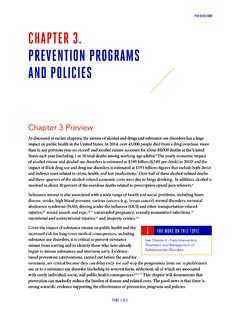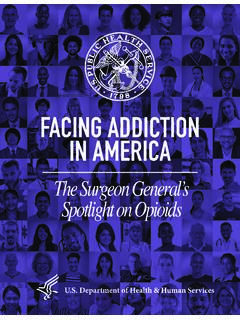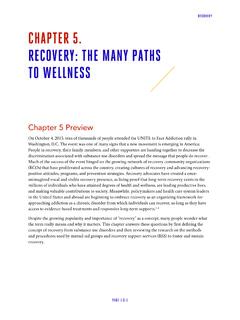Transcription of NEUROBIOLOGY CHAPTER 2. THE NEUROBIOLOGY OF …
1 NEUROBIOLOGYPAGE | 2-1 NEUROBIOLOGYCHAPTER 2. THE NEUROBIOLOGY OF SUBSTANCE USE, MISUSE, AND ADDICTIONC hapter 2 PreviewA substantial body of research has accumulated over several decades and transformed our understanding of substance use and its effects on the brain. This knowledge has opened the door to new ways of thinking about prevention and treatment of substance use CHAPTER describes the neurobiological framework underlying substance use and why some people transition from using or misusing alcohol or drugs to a substance use disorder including its most severe form, addiction. The CHAPTER explains how these substances produce changes in brain structure and function that promote and sustain addiction and contribute to relapse.
2 The CHAPTER also addresses similarities and differences in how the various classes of addictive substances affect the brain and behavior and provides a brief overview of key factors that influence risk for substance use Evolving Understanding of Substance Use Disorders Scientific breakthroughs have revolutionized the understanding of substance use disorders. For example, severe substance use disorders, commonly called addictions, were once viewed largely as a moral failing or character flaw, but are now understood to be chronic illnesses characterized by clinically significant impairments in health, social function, and voluntary control over substance Although the mechanisms may be different, addiction has many features in common with disorders such as diabetes, asthma, and hypertension.
3 All of these disorders are chronic, subject to relapse, and influenced by genetic, developmental, behavioral, social, and environmental factors. In all of these disorders, affected individuals may have difficulty in complying with the prescribed This evolving understanding of substance use disorders as medical conditions has had important implications for prevention and treatment. Research demonstrating that addiction is driven by changes in the brain has helped to reduce the negative attitudes associated with substance use disorders and provided support for integrating treatment for substance use disorders into mainstream health care. Moreover, research on the basic NEUROBIOLOGY of addiction has already resulted in several effective NEUROBIOLOGYPAGE | 2-2 KEY FINDINGS* Well-supported scientific evidence shows that addiction to alcohol or drugs is a chronic brain diseasethat has potential for recurrence and recovery.
4 Well-supported evidence suggests that the addiction process involves a three-stage cycle: binge/intoxication, withdrawal/negative affect, and preoccupation/anticipation. This cycle becomes moresevere as a person continues substance use and as it produces dramatic changes in brain function thatreduce a person s ability to control his or her substance use. Well-supported scientific evidence shows that disruptions in three areas of the brain are particularlyimportant in the onset, development, and maintenance of substance use disorders: the basal ganglia,the extended amygdala, and the prefrontal cortex. These disruptions: (1) enable substance-associatedcues to trigger substance seeking ( , they increase incentive salience); (2) reduce sensitivity of brainsystems involved in the experience of pleasure or reward, and heighten activation of brain stresssystems; and (3) reduce functioning of brain executive control systems, which are involved in the abilityto make decisions and regulate one s actions, emotions, and impulses.
5 Supported scientific evidence shows that these changes in the brain persist long after substance usestops. It is not yet known how much these changes may be reversed or how long that process may take. Well-supported scientific evidence shows that adolescence is a critical at-risk period for substanceuse and addiction. All addictive drugs, including alcohol and marijuana, have especially harmful effectson the adolescent brain, which is still undergoing significant development.* Well-supported: when evidence is derived from multiple rigorous human and nonhuman studies; Supported:when evidence is derived from rigorous but fewer human and nonhuman for the treatment of alcohol, opioid, and nicotine use disorders, and clinical trials are ongoing to test other potential new addictive substances have powerful effects on the brain.
6 These effects account for the euphoric or intensely pleasurable feelings that people experience during their initial use of alcohol or other substances, and these feelings motivate people to use those substances again and again, despite the risks for significant harms. As individuals continue to misuse alcohol or other substances, progressive changes, called neuroadaptations, occur in the structure and function of the brain. These neuroadaptations compromise brain function and also drive the transition from controlled, occasional substance use to chronic misuse, which can be difficult to control. Moreover, these brain changes endure long after an individual stops using substances.
7 They may produce continued, periodic craving for the substance that can lead to relapse: More than 60 percent of people treated for a substance use disorder experience relapse within the first year after they are discharged from treatment,4,6 and a person can remain at increased risk of relapse for many ,8 However, addiction is not an inevitable consequence of substance use. Whether an individual ever uses alcohol or another substance, and whether that initial use progresses to a substance use disorder of any severity, depends on a number of factors. These include: a person s genetic makeup and other individual See the section on Factors that Increase Risk for Substance Use, Misuse, and Addiction later in this | 2-3biological factors; the age when use begins; psychological factors related to a person s unique history and personality; and environmental factors, such as the availability of drugs, family and peer dynamics, financial resources, cultural norms, exposure to stress, and access to social Some of these factors increase risk for substance use, misuse, and use disorders, whereas other factors providebuffers against those risks.
8 Nonetheless, specific combinations of factors can drive the emergence and continuation of substance misuse and the progression to a disorder or an addiction. 1 See CHAPTER 3 - Prevention Programsand Research on the NEUROBIOLOGY of Substance Use, Misuse, and Addiction Until recently, much of our knowledge about the NEUROBIOLOGY of substance use, misuse, and addiction came from the study of laboratory animals. Although no animal model fully reflects the human experience, animal studies let researchers investigate addiction under highly controlled conditions that may not be possible or ethical to replicate in humans. These types of studies have greatly helped to answer questions about how particular genes, developmental processes, and environmental factors, such as stressors, affect substance-taking behavior.
9 NEUROBIOLOGY studies in animals have historically focused on what happens in the brain right after taking an addictive substance (this is called the acute impact), but research has shifted to the study of how ongoing, long-term (or chronic) substance use changes the brain. One of the main goals of this research is to understand at the most basic level the mechanisms through which substance use alters brain structure and function and drives the transition from occasional use to misuse, addiction, and growing body of substance use research conducted with humans is complementing the work in animals. For example, human studies have benefited greatly from the use of brain- imaging technologies, such as magnetic resonance imaging (MRI) and positron emission tomography (PET) scans.
10 These technologies allow researchers to see inside the living human brain so that they can investigate and characterize the biochemical, functional , and structural changes in the brain that result from alcohol and drug use. The technologies also allow them to understand how differences in brain structure and function may contribute to substance use, misuse, and addiction. Animal and human studies build on and inform each other, and in combination provide a more complete picture of the NEUROBIOLOGY of addiction. The rest of this CHAPTER weaves together the most compelling data from both types of studies to describe a neurobiological framework for The study of the anatomy, function, and diseases of the brain and nervous | 2-4A Basic Primer on the Human BrainTo understand how addictive substances affect the brain, it is important to first understand the basic biology of healthy brain function.






